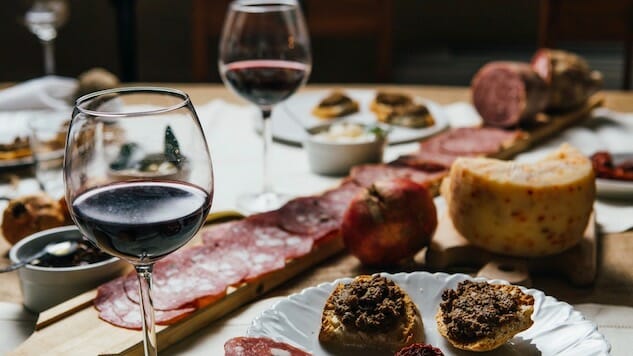52 Wines in 52 Weeks: The Many Faces of Sangiovese
Photo via Shutterstock
Italy’s got so many grape varietals it’s ridiculous-well over 300 that we know of and probably some we don’t-but the one you’re especially likely to have encountered in one form or another is probably Sangiovese. The classic purple-skinned grape of the huge wine-producing region of Tuscany, Sangiovese means “Blood of Jupiter” in Italian, which should give you a decent sense of its importance. Sangiovese is the basis of numerous wines, some rustic and humble, some extremely top-shelf. If you’re drinking something labeled Chianti, Chianti Classico, Brunello di Montalcino, Rosso di Montalcino or vino nobile di Montepulciano, you’re drinking Sangiovese. A red “Supertuscan” blend is Sangiovese that’s adulterated past the blending limits for Chianti (often with Merlot or Ciliegiolo). This is an interesting contrast to, say, Sauvignon Blanc; Where some grapes will grow everywhere but can almost seem like totally different wines based on the latitude, altitude, soil and climate of the site, Sangiovese is grown in massive quantities in northern to central Italy and sparsely if at all in other regions (there are small amounts in Corsica, Greece, California and Washington), yet within that one stretch of terrain it can turn into a vast range of wines depending on how it’s handled.
If you wanted to generalize even more about Sangiovese, you might say it’s pretty tannic, high in acidity, and is not a particularly perfumed wine but has strong flavors of sour cherry and strawberry in its youth and can be earthy, tea-like, leathery or tarry with age and barrel exposure. In my experience, the grape’s such a shapeshifter that generalizations are pointless. In part, this might be due to the vast and not-totally-accounted for number of clones of this grape that can be found intermingled throughout its growing region; in some cases, it’s how a certain sub-region tends to ripen the grape or process it. But there is a Sangiovese at every price tier from “dorm-friend” to “50th Wedding Anniversary,” and styles ranging from resinous and raisiny to light and fruity, earthy no-nonsense table wines to total divas. So probably if there’s a single “something for everyone” berry in the wide world of red wine grapes, it’s possibly this one.
Six Bottles to Try

Avignonesi Vino Nobile de Montepuciano (Tuscany, Italy $25)
Avignonesi is a really old winery in Italy’s oldest DOCG. But today the winery combines its sense of history with a fresh, modern, sustainability-forward approach, and is creating wines that are 100% organic and biodynamic. Whether that accounts for the epic tastiness of this wine I cannot tell you. Vino Nobile de Montepuciano is required by law to contain 70% Sangiovese, and many, if not most, producers do cast a few supporting players, but Avignonesi Vino Nobile is a 100% Sangiovese blended from vineyards in the Montepulciano DOCG. Their vines range from 10-40 years old and tend to sit on the kind of alkaline soil this grape happens to love. The wine features intense aromatics (for me, sour cherry with some spicy sub-notes and a vague hint of mint). This wine is delicate but by no means timorous—medium body, a strong cherry character grounded by herbaceous notes, and a very soft, very lingering finish. Youthful, accessible, wonderful. And a great value for beauty and sophistication without breaking the bank.
Castello Di Albola Chianti Classico (Tuscany, Italy $14)